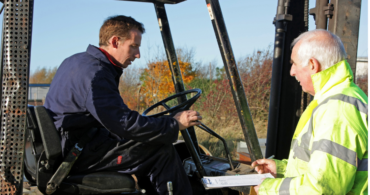Operating a forklift is an incredibly lucrative and rewarding career. However, someone can’t expect to just jump on one of these complex machines and master the mechanics. It is crucial for the safety of the driver, other employees and the entire workplace that operators become forklift certified.
According to the Texas Department of Insurance, when someone starts a new job that involves operating a forklift it is the employer’s responsibility to ensure they take a forklift certification course and know how to use a forklift properly. While this article has a bit of a “how to operate a forklift” vibe, it is not a substitute for a forklift certification course (nor is it trying to be).
How to operate a forklift truck
Before anyone begins operating a forklift truck, they need to perform a daily pre-op forklift inspection. According to OSHA regulation 1910.178(q)(7), “Industrial trucks shall be examined before being placed in service, and shall not be placed in service if the examination shows any condition adversely affecting the safety of the vehicle. Such examination shall be made at least daily. Where industrial trucks are used on a round-the-clock basis, they shall be examined after each shift. Defects when found shall be immediately reported and corrected.”
The operator should inspect their forklift both with the engine off and with it running. The most efficient way to ensure that nothing is missed is to utilize an inspection checklist. Your list will vary depending on the type of machine. Click here for the ultimate guide for creating a forklift checklist.
After your forklift passes its pre-op inspection, it’s time to mount the machine. It may seem overly cautious, but people can injure themselves climbing into the machine (which you really don’t want to do). So, please be cautious, pay attention to wet or slippery surfaces, and remember the three points of contact rule. If you need a refresher, the three points of contact rule states that an individual should always have three points of contact when mounting or dismounting a forklift, which means two hands firmly gripping the hand holds and one foot securely on the running board.
Once you are safely in the vehicle, start the forklift. Some basic forklift controls include:
- Directional controls: Forklifts have three gears: forward, reverse and neutral. These controls are often located on the dashboard or the steering column. In some forklifts, changing gears is foot controlled by shifting the accelerator pedal side to side.
- Mast controls: The tilt control adjusts the angle of the forks, while the lift control raises or lowers the forks.
- Fork controls: These controls adjust the width between the forks to accommodate different pallet sizes.
- Load backrest: A guard behind the forks that helps prevent the load from shifting backward.
- Horn: It’s the horn. Use it to alert pedestrians and other workers when your forklift is in the area.
- Parking brake: This lever or pedal should always be engaged when the forklift is not in motion.
- Emergency stop button: This easily accessible button quickly shuts down all forklift operations in case of an emergency.
The forklift’s operator manual contains specific details on the location and operation of controls for your particular model.
Before you move, make sure your path is clear of obstacles and pedestrians. Always look in the direction of travel (this includes looking behind you when traveling in reverse). If your view is obstructed, use mirrors and spotters to help guide the vehicle. Also, sound your horn to warn pedestrians that your vehicle is on the way.
When picking up a load the forks should be aligned with the center of the pallet. Begin by lowering the forks (you may need to adjust the distance between the forks, if possible). Then approach the cargo slowly and at a straight angle until the forks slide under the pallet as far as possible. Once the forks are properly positioned, lift the load slightly so it clears the ground and tilt the mast backward to stabilize the load. Before moving, ensure that the load is stable and that your path is clear of obstacles and other personnel. Using load backrests and clamps can help prevent a load from shifting during travel.
When traveling with a load the load should be lifted only as far as necessary. It’s generally recommended to travel with the load close to the ground for better stability and visibility. A lower center of gravity reduces the risk of tipping, especially when turning or traveling on an uneven surface. Keep the forklift’s speed steady and moderate and avoid sudden stops and sharp turns.
Forklift basics
Because forklifts can’t talk to you (that feature is about a decade away), they must communicate with operators through indicators and dials displayed on an instrument panel. The gages included on most forklifts are the:
- Speedometer: A forklift is not the smoothest ride available. However, it is still possible to misjudge the vehicle’s speed, which can cause an accident and injury. The speedometer is necessary for the operator to maintain a safe operating speed.
- Directional indicator: No one wants to by the guy who accidently reverses off a loading platform. The directional indicator shows whether you are in forward or reverse and helps prevent dangerous (and meme-able) accidents.
- Brake system indicator: Even a minor problem with the forklift’s braking system will trigger this indicator. Operators should immediately stop the forklift and have someone perform a maintenance check of the braking system.
- Hour meter: There are several reasons for you to know the total hours a vehicle has been in operation, such as keeping a maintenance schedule, tracking battery usage and monitoring wear and tear.
- Battery charge indicator: This gauge shows the battery charge level in an electric forklift so operators can manage usage and recharging.
- Temperature gauge: Overheating can cause performance issues and potentially damage the motor.
- Oil pressure gauge: Without sufficient oil pressure, the engine operates with decreased lubrication, which increases friction and heat and can potentially damage the motor. A broken hose, an oil pump failure or a leaking gasket are just a few of the problems that will result in an oil pressure gauge warning.
- Load weight indicator: Some heavy-duty forklifts may include a load weight indicator that helps operators ensure they are within the truck’s safe carrying capacity.
Read the operator’s manual to learn about the instruments in your specific forklift model. Never operate your forklift if a warning light or gauge indicates a potentially unsafe condition.
At Texas Motive Solutions, we have the forklift batteries and accessories you need to keep your fleet running. Plus, if you have any questions about our “how to drive forklift for beginners” article and more, we provide a complimentary forklift fleet performance analysis to guarantee you have the correct batteries for your needs.
Give us a call at (888) 316-2459 or fill out this form to discover everything Texas Motive Solutions can do for you.


